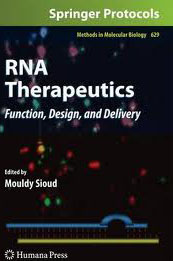RNA therapeutics
Function, design and delivery

RNA therapeutics |
 |
Methods in Molecular Biology, vol. 629
Humana Press - Springer Protocols
Pages: 542; 100 figs; € 109,95€
SBN: 978 -1- 60761- 656 - 6
European Journal of Histochemistry 2011; 55
As well known, the 2006 Nobel Prize in Physiology or Medicine 2006 was awarded jointly to Andrew Z. Fire and Craig C. Mello for their discovery of RNA interference - gene silencing by double-stranded RNA, in other words, to acknowledge that RNA modulates gene expression! This consciousness has opened an entire world of activities for the scientific community, from basic researches to clinical applications. Here, the efforts of Prof. Sioud (Dept. of Immunology, Norvegian Radium Hospital, Inst. for Cancer Research, Oslo, Norway) to give us an update statement of the present day possible use of RNA to treat several diseases are well presented thanks to a 30 chapters walk in the RNA world. After some introductory chapters explaining the RNA modifications able to modulate post-transcriptionally gene expression, we enter the crucial step of RNA delivery to mammalian cells for the practical clinician use of RNA molecules. What it is actually needed is a targeted delivery, not only a general delivery to the cell, to improve therapeutic efficacy and health safety. Thus, some chapters are dealing with the delivery strategies we hand nowadays and with the novelties are sorting out (nanotechnologies to deliver oligonucleotides) while discussing the theoretical needs for efficient delivery and describing step by step methods and valuable protocols for the design of effective RNA sequences. Other chapters (12 and 13) describe microarray technology to detect the silencing of several genes in a while, a useful technique that is expected to help in drug target validation. Interestingly enough, at this point of the chapters presentation (we are at about half of the book) the covered topics apparently become more basic science: they start to deal with the explanations on nature and origins of micro RNA and silencing RNA, well telling us like in a splendid scholar textbook the biogenesis of these molecules and their interactions. This seems the reason to get these information at the half part of the book: these explanations are introductory to chapter 15, where the possible risk of the miRNA biogenesis inhibition are presented clearly telling that this danger arise from the fact that several effector proteins are shared by siRNA and miRNA.
Some other chapters cover the most recent improvements in the therapeutic use made by exploiting the capacity of certain RNAs to perform catalysis (trans-cleaving ribozymes). Some practical examples of this type of translational research are presented (e.g. chapter 20 by Sang-Jin Lee and colleagues describing the in vivo reprogramming, the conversion, of human telomerase reverse transcriptase-encoding RNA to therapeutic transgene herpes simplex virus thymidine kinase to target tumor cells: a very detailed protocol full of useful practical notes to avoid pitfalls). Cancer immunotherapy, the generation of therapeutic T-cell, breaking self-tolerance to tumor cells, aptamers (small structured single-stranded RNAs or DNAs) as therapeutic tolls are some of many other interesting topics covered by the book. Clearly enough, the book is of great interest to the entire scientific community, no matter if basic researchers, teachers or clinicians!
CarloAlberto Redi
University of Pavia, Italy
[TOP]